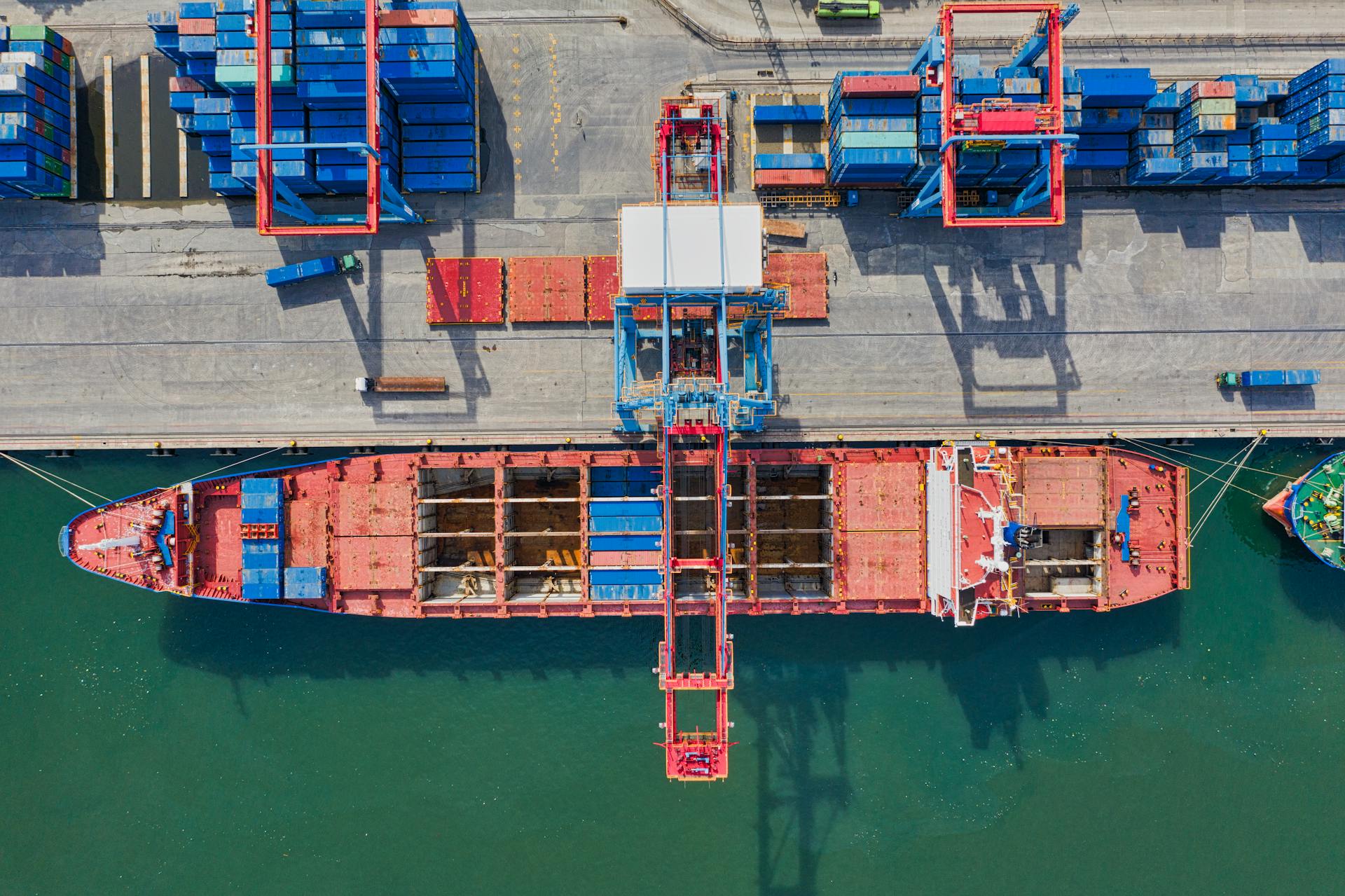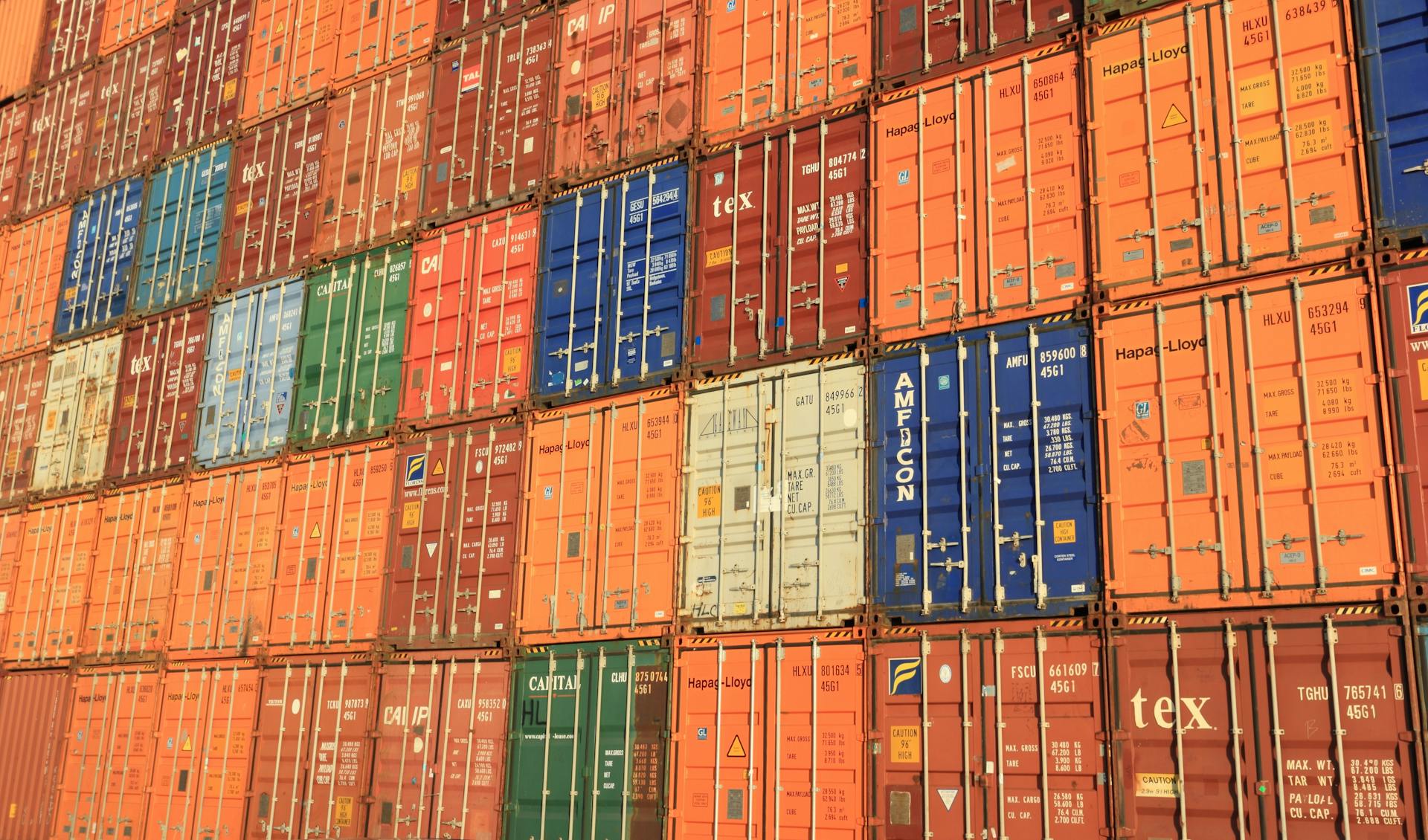
Inland waterway transport is a vital mode of transportation that plays a significant role in the global economy. It's a cost-effective and environmentally friendly way to move goods, with the European Union's inland waterway network alone accounting for over 10% of the region's total freight traffic.
Inland waterways connect major cities and industrial areas, making them an essential link in the supply chain. They can transport a wide range of cargo, from bulk commodities like coal and grain to containers and even oversized project cargo.
The benefits of inland waterway transport are numerous, including reduced emissions and noise pollution compared to road transport. In fact, a study found that inland waterways produce an average of 2.5 grams of CO2 per ton-kilometer, compared to 35.3 grams for road transport.
Inland waterway transport is also highly efficient, with vessels able to carry large volumes of cargo while using less energy than trucks or trains.
Types of Commodities and Services
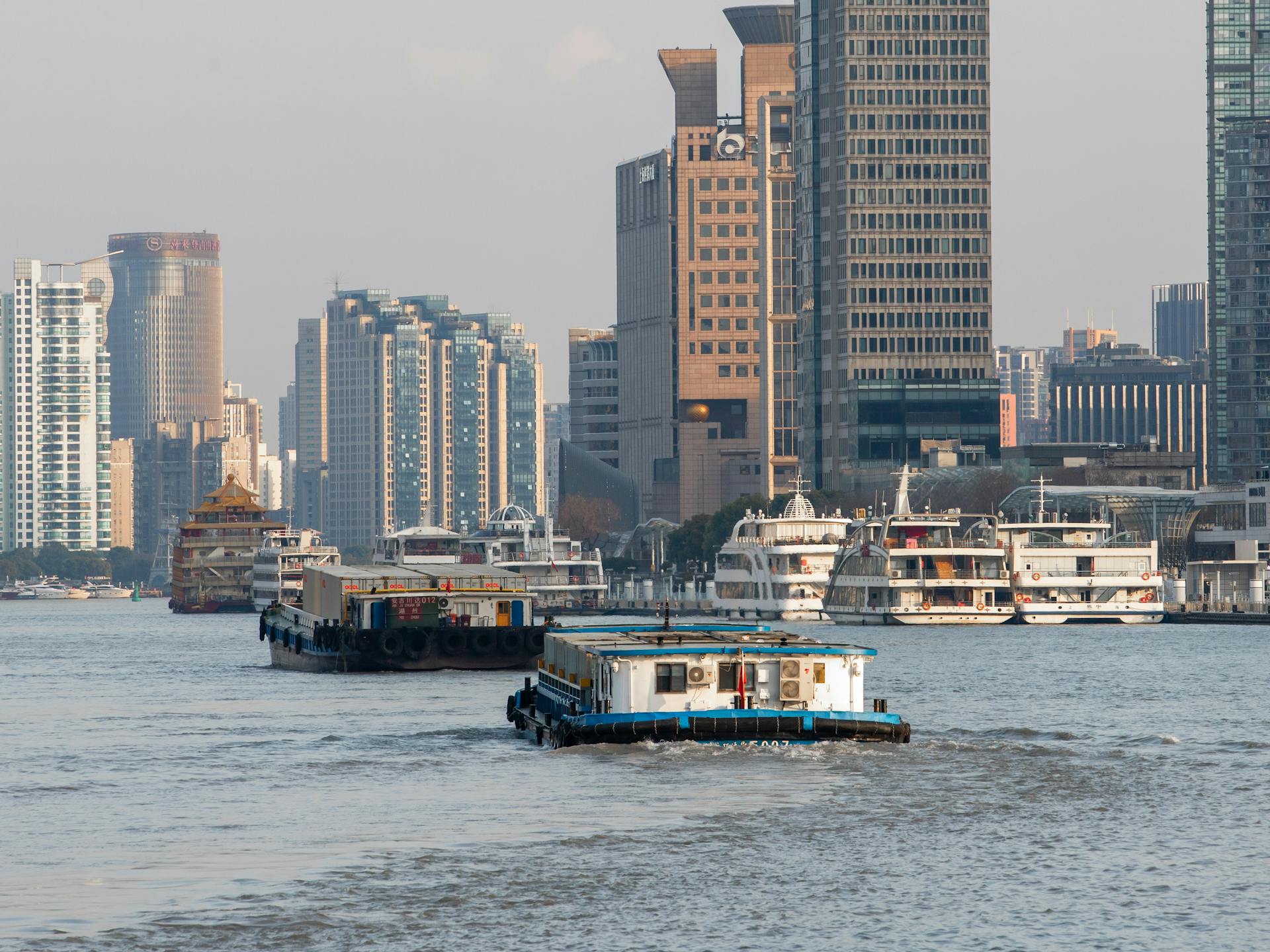
Inland waterway transport is a versatile mode of transportation that can carry a wide variety of commodities. Container barges, for instance, are designed to carry standard shipping containers, allowing seamless integration with international maritime shipping.
Dry bulk commodities, such as construction materials and agricultural products, are commonly transported by inland waterways. These include goods like sand, gravel, crushed stone, corn, and wheat.
Roll-on/Roll-off (RoRo) services are useful for short-distance movement of trucks and trailers, allowing vehicles to be driven on and off ferries or barges for transportation across waterways.
What Are Iwts?
Inland water transport (IWT) is a vital mode of transportation that moves people and goods on navigable waterways like rivers, canals, lakes, and other inland bodies of water.
Navigable waters are categorized based on their size, depth, and the type of vessels they can support. These categories help understand the capacity and capability of different inland waterways to support various types of cargo and vessel sizes.
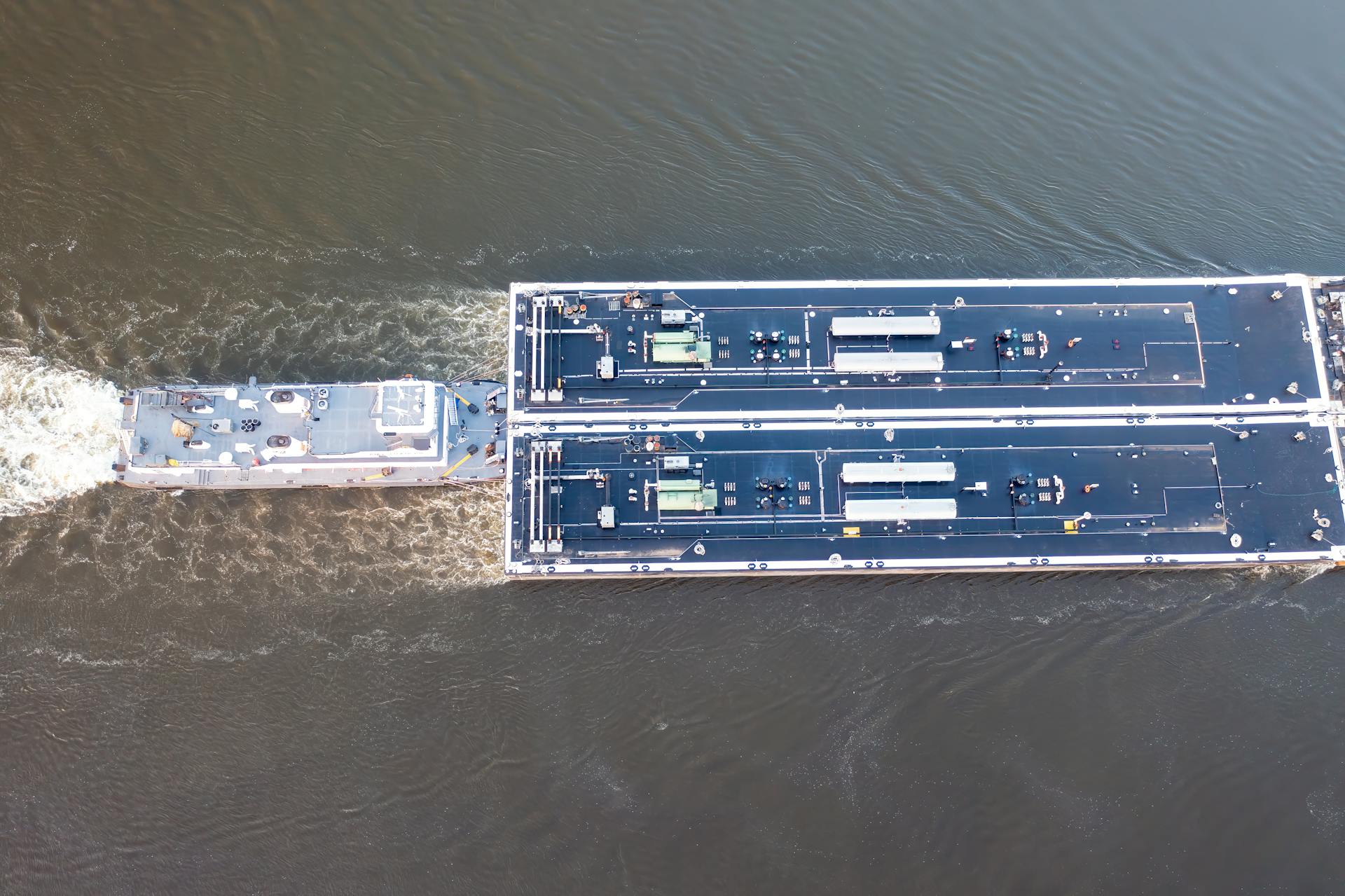
Class I waterways are suitable for vessels and barges with shallow drafts, while Class II and III waterways can accommodate medium-sized vessels. Class IV to VI waterways, on the other hand, are capable of supporting substantial commercial ships and bulk carriers.
Understanding these categories is essential for businesses and individuals who rely on IWT to transport goods and commodities.
Freight Services Offered
Freight services offered in inland water transportation are designed to efficiently move goods across waterways. Container barges are a key part of this process, allowing standard shipping containers to be easily transported.
Roll-on/Roll-off (RoRo) services are another essential service, utilizing ferries or barges equipped with ramps to transport vehicles across waterways. This is particularly useful for short-distance movement of trucks and trailers.
Intermodal transportation is a crucial aspect of inland water transportation, enabling cargo to be transported using a combination of modes such as truck, rail, and barge to reach its final destination. This approach streamlines the transportation process and reduces costs.
Lighterage services are also offered, involving the transfer of cargo between barges and other vessels or land-based transportation at ports or terminals.
Types of Commodities
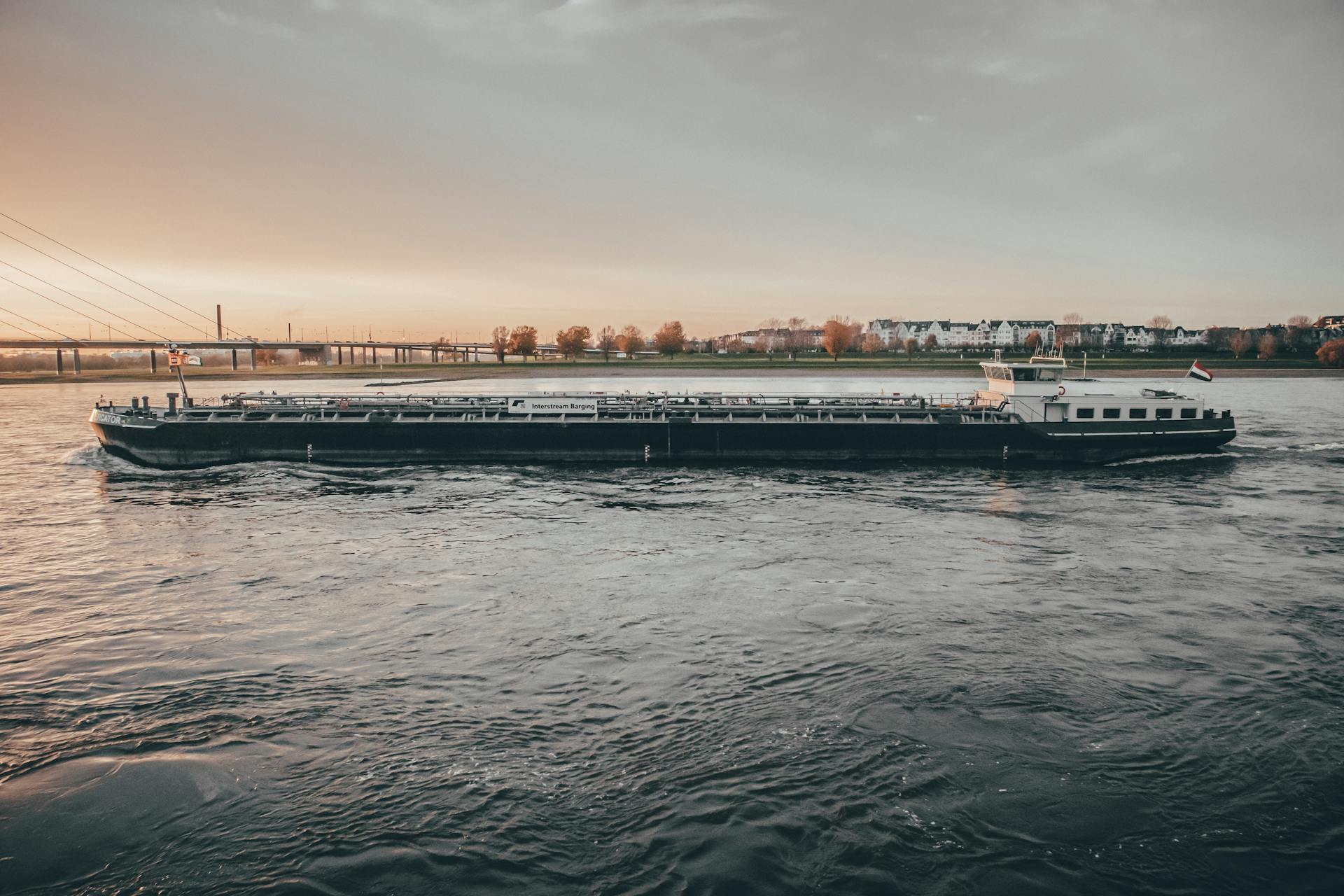
Dry bulk commodities are transported in large quantities and include construction materials like sand and gravel, minerals like coal and iron ore, and agricultural products like corn and wheat.
Construction materials like sand and gravel are often transported as dry bulk commodities.
Loose, unpackaged goods like minerals and agricultural products are also transported as dry bulk commodities.
Petroleum products like crude oil and gasoline are transported as liquid bulk commodities in large volumes.
Industrial chemicals and liquid fertilizers are also transported as liquid bulk commodities.
Individual pieces of freight like logs and lumber are transported as breakbulk cargo.
Forest products like pulpwood and machinery like construction equipment are also transported as breakbulk cargo.
Containerised cargo includes goods packed in standard carrier ocean containers like steel products and agricultural products.
Steel products like coils and pipes are often transported as containerised cargo.
Importance and Benefits
Inland waterway transport is a crucial strategy for achieving sustainable development in hinterland transportation. It can meet massive demand and improve economic and environmental performance.
IWT provides solutions for economic development, population growth, and climate change. This mode of transport is recognized as a critical factor for developing sustainable transportation by the European Union.
One of the key benefits of IWT is its ability to reduce external costs. In fact, external costs related to IWT are 19 euros less per 1000 ton-km compared to road.
Commercial benefits of IWT have been reported since 1995. The advantages include low-cost transportation of heavy and bulk goods, making it an attractive option for industries.
The cost-benefit analysis in Poland concluded that waterways base model investment is profitable using the Vistula River. This is due to savings in costs related to cargo, accidents, congestion, pollution, emissions, and more.
IWT can also improve economic activities such as tourism, hydroelectric production, and the inclusion of new trades. For instance, the automotive industry can benefit from distributing cars via IWT from production plants to distribution centers.
Using intermodal transport for palletized goods in Brussels-Capital Region has economic potential and can be successfully transported by barges. This mode of transport also generates less external costs compared to road transport.
IWT is the cheapest transport mode and can reduce costs related to flood losses, accidents, pollution, climate change, noise, congestion, and transport costs.
Challenges and Limitations
Inland waterway transport presents some limitations when integrating it into your supply chain strategy.
Despite the compelling advantages of inland water transportation, it has some challenges. One of the main limitations is that inland waterways can be unpredictable, with factors like weather, water levels, and navigation restrictions affecting shipping schedules and costs.
The unpredictability of inland waterways can lead to increased costs and reduced reliability for businesses that rely on them for transportation.
Infrastructure Limitations
Infrastructure limitations can be a major hurdle for businesses using inland water transportation. Many rivers and canals have shallow waterways that can't accommodate large barges, restricting cargo weight.
To tackle this issue, it's essential to identify available terminal/quay infrastructure that allows vessels to berth. This can be a game-changer for businesses that need to transport heavy cargo.
Carefully planning routes that utilize deeper sections of waterways is also crucial. Consider using smaller vessels for specific stretches where larger ones won't fit.
Staying informed about government or industry initiatives regarding inland water transportation is also a good idea. Lobbying for infrastructure projects that benefit your business needs can be a proactive approach.
Here are some key considerations to keep in mind when navigating infrastructure limitations:
- Look for companies with expertise in navigating IWT infrastructure limitations.
- Carefully plan routes that utilize deeper sections of waterways and consider using smaller vessels for specific stretches.
- Stay informed about government or industry initiatives about IWTs.
Choosing Right Transport: Road vs Rail
For shorter hauls, road transport is the way to go if you need speed and flexibility. It's perfect for situations where you're in a hurry.
Road transport is great for shorter distances because it's faster than rail, which is better suited for long-distance hauls. This is especially true if you need to make frequent stops or changes in route.
If you're transporting bulk goods, rail might be a better option due to its reliability and long-distance capabilities. However, road transport can be more cost-effective for shorter hauls.
Here's a quick comparison of road and rail transport:
Ultimately, the choice between road and rail transport depends on your specific needs and the factors mentioned in the article, such as distance, cargo type, and fuel prices.
Costs and Comparison
Inland waterway transport can be a cost-effective option, but there are some key expenses to consider.
Tolls can vary greatly depending on the waterway, cargo type, and distance travelled. Some waterways may charge tolls for usage, similar to highways.
Port and terminal fees are also expenses you'll need to factor in, which can include expenses for loading, unloading, and storing cargo.
Fuel consumption is another significant cost, which can vary depending on the size and type of vessel, cargo weight, and waterway conditions.
Intermodal costs can add up if you need to integrate inland waterway transport with other modes of transportation, such as road or rail, for origin or destination points not directly accessible by waterways.
Route planning can also add costs, especially if you need to navigate around limitations of specific waterways, such as depth or lock sizes, to optimise travel time and minimise tolls or congestion.
Seasonality can impact costs, particularly during low-water periods when you might need to use smaller vessels or adjust loading capacities, which can impact efficiency and potentially increase costs.
Goods and Fleet Overview
Inland waterway transport offers a reliable way to move goods across Europe. With a large fleet of ships, Rhenus has the largest inland waterway fleet in Europe, consisting of around 1,000 ship units in daily use.
Our fleet is equipped to handle a variety of cargo, including bulk goods and general cargo. We also offer specialized services for GMP goods, thanks to our GMP certification of our shipping fleet.
- Our fleet includes seven bilge de-oiling boats, which are responsible for disposing of waste containing oil and grease from ship operations.
- We have seven bunker boats that operate on all European waterways, supplying goods and passenger ships with lubricants and fresh water.
- Containers can be transported efficiently and in an environmentally friendly way on inland waterway vessels in the European river network.
This efficient and reliable transportation method is ideal for just-in-time projects, ensuring that your freight is in the right place at the right time.
Goods Overview
We transport a variety of goods on inland waterways, including waste products like waste wood, glass, contaminated soil, and industrial slag, which meet European requirements.
Our fleet is equipped to handle bulk goods, general cargo, and GMP goods, thanks to the GMP certification of our shipping fleet.
We have seven bilge de-oiling boats that collect and dispose of waste containing oil and grease from ship operations, a crucial task to maintain waterway cleanliness.
Our seven bunker boats supply goods and passenger ships with lubricants and fresh water on all European waterways.
We're able to offer a range of logistics services, from transporting waste products to supplying ships with essential resources, thanks to our expertise and experience.
Europe's Largest Fleet
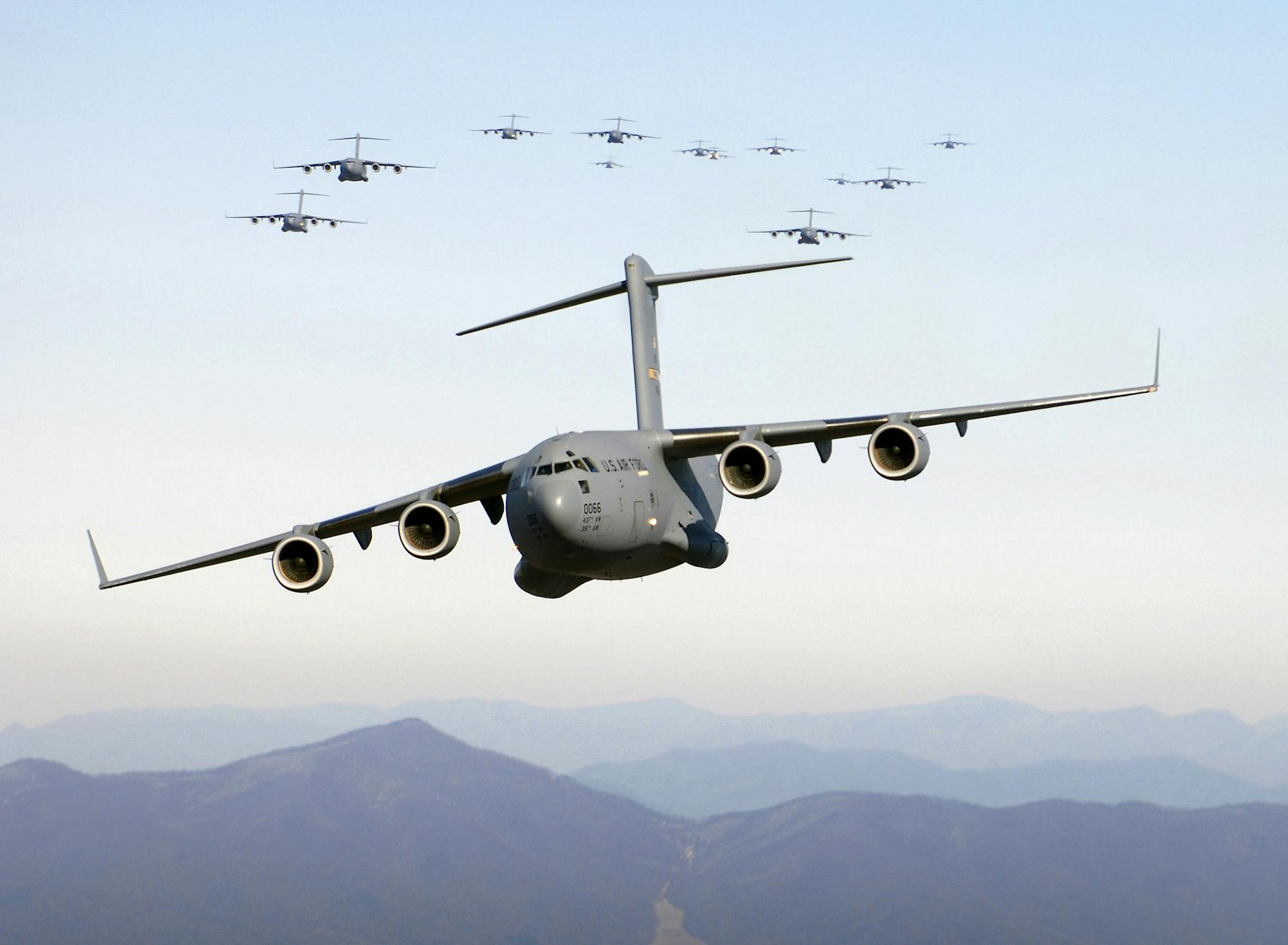
Our fleet is truly massive, with around 1,000 ship units in daily use – that's the largest inland waterway fleet in Europe.
We have a huge network of branches that enables us to transport your products across borders throughout Europe.
With over 200 years of experience, we've developed a solution for every logistics need and ensure that your logistics operations run smoothly.
We've got a diverse fleet that includes self-propeller vessels, convoys of barges, and even touring boats – each designed to transport goods efficiently and safely.
Here's a breakdown of our fleet:
- Self-propeller vessels
- Convoys of barges
- Touring boats
Our fleet is used for a variety of tasks, including transporting goods, supplying ships with lubricants and fresh water, and even collecting and disposing of waste containing oil and grease from ship operations.
We've got a strong focus on safety, with a low rate of incidents and accidents – but we're always looking for ways to improve and strengthen our operations.
Sustainable Development
Sustainable Development is a crucial aspect of inland waterway transport. It's development that meets the needs of the present without compromising the ability of future generations to meet their own needs. This concept is often referred to as "development that does not deplete natural resources, but rather preserves them for future generations" (Brundtland 1987).
Several authors have discussed various characteristics to explain the concept of sustainable development of IWT. For the present research, the sustainable development of IWT can be understood as the development of the IWT, which promotes better environmental practices and considers socio-economic aspects.
The European Union has recognized the importance of waterborne transport as a critical factor for developing sustainable transportation. In fact, the European Union has guidelines for sustainable transport, which contains three main points: basic access and development needs of individuals, affordable and efficient transportation, and limit emissions and use renewable resources (Rohács and Simongáti 2007).
Environmental Benefits
Inland waterway transport (IWT) is a game-changer for reducing greenhouse gas emissions, producing 40% fewer emissions than road transport (Hofbauer and Putz 2020). IWT also generates four times less CO2 and emits 2.6 times fewer greenhouse emissions than road transport (Oulfarsi 2016).
IWT is a fuel-efficient mode of transportation, consuming less fuel per ton-kilometre than trucks (Rohács and Simongáti 2007). Diesel consumption of IWT is lower than road and rail transportation, with energy consumption about 75% less than road (Gołȩbiowski 2016).
Reduced congestion is another benefit of IWT, as it takes bulk goods off roads and highways, improving overall supply chain efficiency (Example 2). This not only reduces traffic congestion but also decreases air and noise pollution.
IWT is also an environmentally friendly mode of transportation, with lower levels of pollution and noise compared to other hinterland transportation modes (Blonk 1994). In fact, a river convoy generates four times less CO2 and emits 2.6 times fewer greenhouse emissions than road transport (Oulfarsi 2016).
The adoption of greener solutions, such as promoting the use of renewable energies instead of fossil fuels, is a priority among policymakers worldwide (Woś et al. 2022). This, combined with water management plans that take into consideration ecological conditions, can further reduce the environmental impact of IWT.
Drivers for Sustainable Development
The concept of sustainable development is multifaceted, and understanding its drivers is crucial for achieving it. IWT represents one of the most important strategies to achieve sustainable development in hinterland transportation for its ability to meet massive demand and improve economic and environmental performance.
IWT provides solutions for economic development, population growth, and climate change. It's a viable alternative to road and rail transport, and one of the most economical modes of inland transportation.
By taking bulk goods off roads, IWT helps alleviate traffic congestion on highways and railways, improving overall supply chain efficiency. Lower greenhouse gas emissions compared to trucks make IWT a more environmentally friendly option.
Countries near the flow of rivers have demonstrated economic growth over time. Commercial benefits of IWT have been reported since 1995, with advantages related to low-cost transportation of heavy and bulk goods.
Several economic activities could be improved or implemented along with IWT development, such as tourism, hydroelectric production, or the inclusion of new trades. IWT is the cheapest transport mode and generates less external costs in comparison with the road.
IWT supports rural development and is relevant to passenger transport, especially in regions where road access is almost nil. It impacts the well-being of citizens due to the increase in goods transportation and the positive effects of flood stabilization.
Some countries in Asia recognize IWT as one of the safest means of transport due to its low number of fatalities or injuries. IWT can contribute to diminishing road congestion, which is one of the major issues related to hinterland transportation.
Infrastructure and Budget
The cost of building and maintaining inland waterway infrastructure is significant, with a single kilometer of canal costing around $1.5 million to $3 million.
In Europe, the Rhine-Main-Danube waterway, a major transportation route, required an investment of over €1.3 billion to upgrade and expand its capacity.
The European Union's Cohesion Fund has provided substantial financial support for inland waterway projects, with the Netherlands alone receiving over €1.5 billion in funding.
The budget for the Danube River's navigability improvements was around €1.2 billion, allocated from the EU's European Regional Development Fund.
Investing in inland waterway infrastructure can bring substantial economic benefits, with estimates suggesting that a 10% increase in waterway capacity can lead to a 3% increase in GDP.
Eco-Friendly and Support
Inland waterway transport (IWT) is an eco-friendly mode of transportation that's gaining momentum. It offers a promising alternative to congested roadways and railways, reducing greenhouse gas emissions by approximately 40% compared to road transport.
IWT consumes less fuel per ton-kilometre than trucks, with diesel consumption being lower than road and rail transportation. In fact, a river convoy generates four times less CO2 and emits 2.6 times fewer greenhouse emissions than road transport.
Here are some key environmental benefits of IWT:
- Reduced congestion: IWT helps alleviate traffic congestion on highways and railways, improving overall supply chain efficiency.
- Lower greenhouse gas emissions: IWT produces less air and noise pollution compared to trucks and other land vehicles.
- Lower energy consumption: IWT consumes about 75% less energy than road transport.
By adopting greener solutions, such as promoting the use of renewable energies instead of fossil fuels, and improving and optimizing inland vessels, IWT can provide several environmental and economic benefits.
Environmental Drivers
IWT is the most environmentally friendly mode of internal transport, especially when it comes to CO2 release. It's approximately 40% lower than road transport, according to Jonkeren et al. (2019).
Greenhouse gas emissions from river convoys are significantly lower, generating four times less CO2 and emitting 2.6 times fewer greenhouse emissions than road transport. This is a remarkable achievement, especially considering the massive volumes of cargo that can be transported by water.
River convoys consume less fuel per ton-kilometre than trucks, making them a more energy-efficient option. In fact, diesel consumption of IWT is lower than road and rail transportation, with energy consumption being about 75% less than road transport.
Noise pollution and land use are also lower compared with other hinterland transportation modes, making IWT a more environmentally friendly choice. This is particularly important for areas with high population density or sensitive ecosystems.
The high carry capacity of waterborne transport is another significant advantage, allowing it to reduce pollution and road congestion. A single barge can replace between 70 and 80 trucks that travel to the same place, according to Roso et al. (2020).
While IWT is the slowest hinterland transport mode, it's mainly attractive for the transport of non-perishable products, such as construction materials, agricultural raw materials, and petroleum products. This makes it an ideal option for transporting large volumes of cargo.
Eco-Friendly Mode
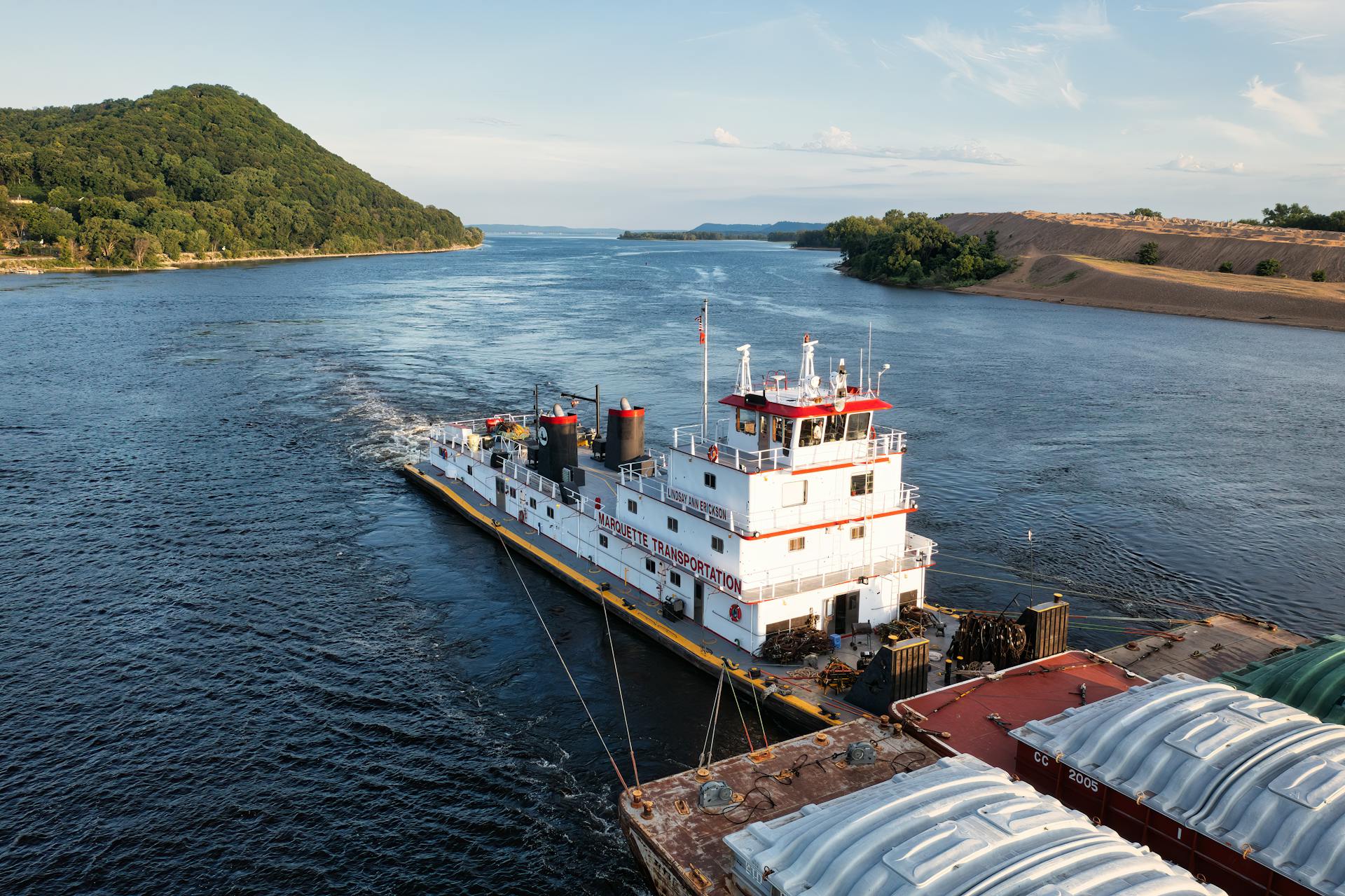
Inland Waterway Transport (IWT) is an eco-friendly mode of transportation that's gaining momentum. It harnesses rivers, canals, lakes, and other navigable water bodies to transport goods and people, offering a promising alternative to congested roadways and railways.
IWT is a low-carbon mode of transportation, producing 40% lower greenhouse gas emissions compared to road transport. It also consumes less fuel per ton-kilometre than trucks, with diesel consumption being lower than road and rail transportation.
IWT is not only environmentally friendly but also economically beneficial. It offers a cost-effective way to transport heavy and bulk goods, with external costs being 19 euros less per 1000 ton-km compared to road. In fact, a cost-benefit analysis in Poland concluded that waterways base model investment is profitable using the Vistula River.
One of the most significant advantages of IWT is its ability to alleviate traffic congestion on highways and railways. By taking bulk goods off roads, IWT helps improve overall supply chain efficiency and reduces the number of vehicles required to transport goods.

Here are some key benefits of IWT:
- Reduced congestion
- Lower greenhouse gas emissions
- Lower fuel consumption
- Lower external costs
- Improved supply chain efficiency
IWT is also a safe mode of transportation, with a low number of fatalities or injuries compared to other modes of transport. It can contribute to diminishing road congestion, which is one of the major issues related to hinterland transportation.
In conclusion, IWT is a vital component of modern logistics and transportation systems, offering a sustainable and efficient way to transport goods and people. Its benefits extend beyond the environment to the economy and society, making it an attractive option for countries and industries looking to reduce their carbon footprint and improve their supply chain efficiency.
Frequently Asked Questions
What are examples of inland transport?
Inland transport includes various modes such as road, rail, inland waterways, and pipelines. These modes facilitate the movement of both passengers and goods across land.
Sources
- https://www.maersk.com/logistics-explained/transportation-and-freight/2024/08/16/inland-water-transport
- https://www.rhenus.group/inland-waterway-transport/
- https://jshippingandtrade.springeropen.com/articles/10.1186/s41072-023-00162-9
- https://www.inlandwaterwaytransport.eu/press-release-inland-water-transport-indispensable-europe/
- https://www.hamburgportconsulting.com/sectors/hinterland/inland-waterway-transport/
Featured Images: pexels.com

